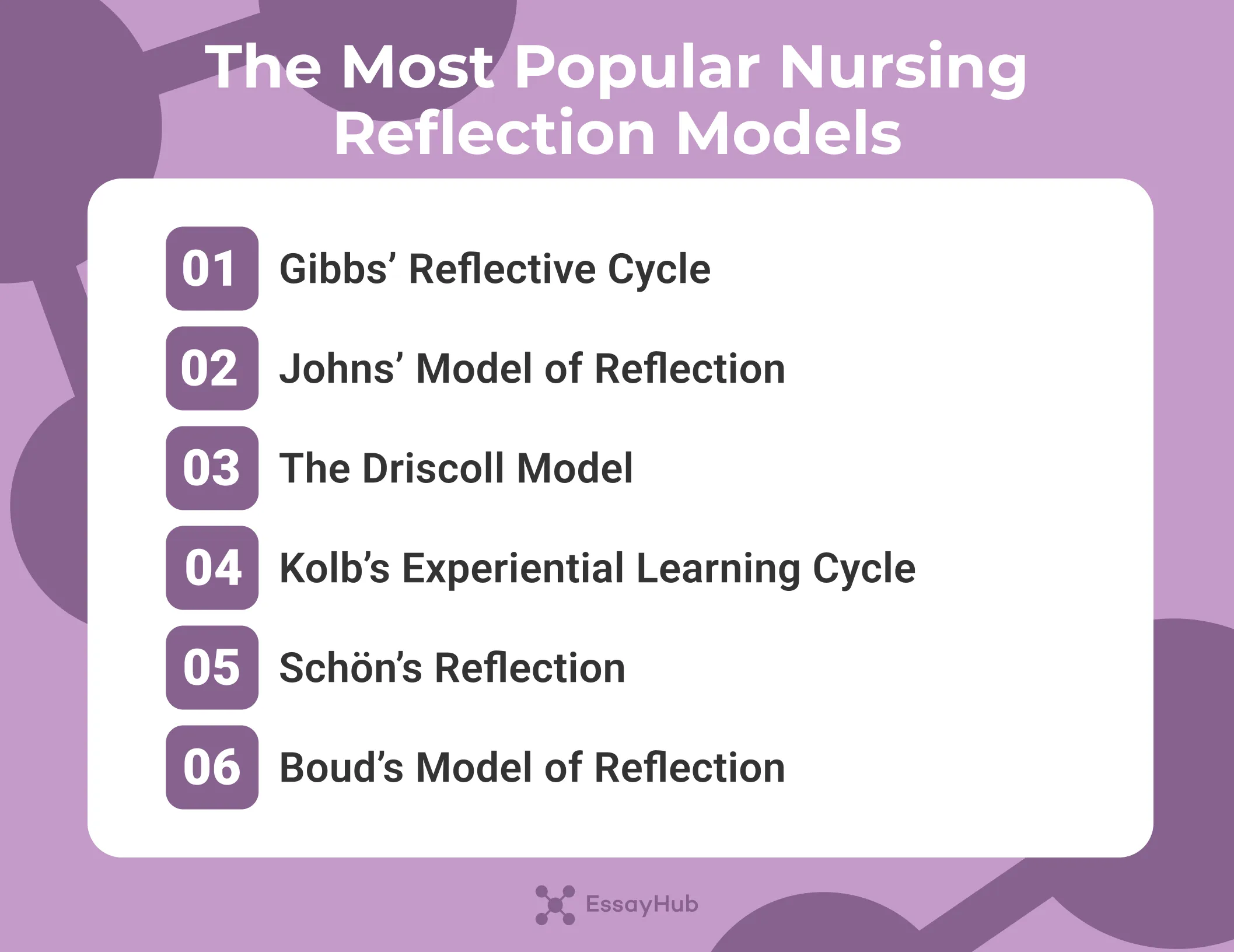Every nurse carries memories that never fade: the first patient lost, the shift that felt impossible, the moment when everything finally made sense. These experiences, however painful, shape you as a professional. The reported 54% of nurses who experience emotional exhaustion clearly show that reflection in this field is not optional. Rather, it’s how nurses stay grounded when the work gets heavy. And it does get heavy.
This article brings together real nursing reflection examples for students who want to improve their reflective writing. But if putting your thoughts into words feels even more overwhelming than clinical practice, EssayHub's professionals can step in to help.
What Is Nursing Reflection?
Nursing reflection is a structured way to think about what happens during clinical practice. You take one situation and study it in detail. You try to understand how you react and grow as a professional. A nursing essay built around reflection follows the same logic: it shows how a single event can develop into a deeper understanding.
The purpose remains practical. Reflection allows nurses to see where they succeeded or fell short. Through repetition and careful review, they become more aware and precise. The process builds a habit of measured response instead of impulse. Difficult experiences begin to take shape under closer thought. From there, new insight grows and guides nurses toward stronger, more reflective practice.
Different Types of Nursing Reflection
Over the years, educators and researchers have created nursing reflection models that bring structure to the process. These frameworks show where to start and how to reach meaningful conclusions about practice. The most popular models of nursing reflection are:

- Gibbs' Reflective Cycle: This model breaks reflection into six clear steps: description, feelings, evaluation, analysis, conclusion, and action plan. Many nursing students view it as the best reflective model because it turns reflection into a straightforward, repeatable process.
- Johns' Model of Reflection: Johns encourages nurses to look deeper. His model uses guiding questions that reach beyond actions into beliefs, ethics, and values. It helps nurses understand why they felt a certain way and how personal principles influenced their choices.
- The Driscoll Model: Built around three direct questions, What? So what? Now what? This model keeps things simple. It moves from description to meaning, then to future change. The focus stays on practical outcomes rather than long analysis.
- Kolb's Experiential Learning Cycle: Kolb describes learning as a continuous cycle. You experience something concrete, reflect on it, form a general idea, and test that idea through action. Nurses use it to turn every patient interaction into part of an ongoing learning loop.
- Schön's Reflection: Schön divides reflection into two kinds. Reflection-in-action happens in the moment, while reflection-on-action happens later. Both matter because they make sure nurses think critically.
- Boud's Model of Reflection: Boud emphasizes emotion as part of learning. His model asks nurses to first acknowledge how they felt about an event before analyzing it. Once emotions are recognized, reflection becomes more honest and balanced.
Guidelines for Writing a Nursing Reflection
Writing a nursing reflection takes patience and focus. It asks you to clarify what the experience meant and what changed because of it. The points below provide academic writing tips that help nurses write with clarity.
- Situation Overview
a. Say where the described things happened.
b. Describe what took place.
c. Share what you were thinking at that moment.
- Critical Analysis
a. Think about why the situation turned out the way it did.
b. Link what you learned in class to what you did in practice.
c. Explain how your actions affected what happened next.
d. Point out one thing you did well and one thing you could improve.
- Insights
a. Write what you learned from the experience.
b. Explain what it taught you about caring for patients.
c. Describe how this lesson will help you in future work.
- Self-Reflection
a. Choose one action to improve your skills.
b. Set a clear goal for your nursing growth.
c. Explain how you'll work on any weak areas in similar situations.
- Self-Awareness
a. Be honest about your feelings
b. Name the values that guided your behavior.
c. Explain how those values shaped your decisions.
- Alignment to Professional Standards
a. Look at the nursing rules or codes linked to the event.
b. Show how your reflection fits with those standards.
c. Explain how following them helps you act more responsibly.
Structure of a Nursing Reflection
A reflection grows stronger when it follows a clear path. Each model arranges these points differently. Some focus on emotion, while others emphasize analysis. The pattern remains the same: reflect on what happened and provide better care next time. The table below shows a common framework used in nursing programs:
Nursing Reflection Example #1
This short nursing reflection example follows the Driscoll model, which asks three guiding questions that naturally fit within a structured reflection: What? So what? Now what?
Description: During a wound dressing, I noticed a nurse touching sterile tools without sanitizing their hands first. I finished assisting but felt uneasy about not speaking up.
Initial Reaction: I felt nervous and unsure. I didn't want to cause conflict, yet I knew it was a safety risk.
Analysis: The procedure went fine, but my silence bothered me. Ignoring a hand hygiene issue means overlooking a possible infection risk.
Insights: I learned that safety matters more than comfort. Speaking up protects patients and supports good teamwork.
Action Plan: Next time, I'll politely raise safety concerns right away and follow infection control policy more closely.
Self-Awareness: I tend to hesitate when I fear confrontation. Knowing this helps me prepare to act confidently in similar cases.
Connection to Professional Standards: This reflection supports nursing standards that require maintaining hygiene and addressing safety concerns to ensure patient protection.
Nursing Reflection Example #2
This nursing reflection example using Gibbs model follows six stages that help nurses unpack both emotion and action in detail.
Description: I was asked to prepare an IV line for a postoperative patient. I missed the vein on the first attempt and felt pressure because the patient showed discomfort.
Initial Reaction: I felt embarrassed and tense. I could sense my hands stiffening. My concern was that the patient would stop trusting me.
Analysis: The second attempt went smoothly because I slowed down and followed protocol step by step. I realized my first failure came from rushing. Confidence became more important to me at that moment than taking a steady approach.
Insights: I understood that skill improves through patience, not speed. Confidence should grow from consistency, not appearance.
Action Plan: I will keep practicing IV insertion on training models and ask supervisors for direct feedback. My goal is to balance precision with empathy.
Self-Awareness: I noticed how strongly my emotions affect my performance. When I feel pressure, my focus shifts away from the patient. Recognizing that helps me ground myself in calm, deliberate actions.
Connection to Professional Standards: The reflection supports professional expectations of safe practice, clear communication, and ongoing skill development.
Nursing Reflection Example #3
This example of nursing reflection follows Kolb's cycle, which views learning as a loop that connects nursing experience with future action.
Description: While working in a rehabilitation unit, I assisted a stroke patient with mobility exercises. The patient became frustrated and refused to continue.
Initial Reaction: I felt helpless and uncertain. My instinct was to step back and give space, though I sensed that might not help.
Analysis: The event showed that I lacked strategies for motivating patients in recovery. My silence increased the frustration. I should have offered gentle encouragement or adjusted the exercise pace.
Insights: I learned that emotional engagement is part of physical rehabilitation. Understanding the patient's frustration builds trust and helps restore motivation.
Action Plan: I will read more about motivational communication in physiotherapy settings and observe experienced nurses who guide resistant patients. My aim is to develop supportive communication habits.
Self-Awareness: I realized that I often equate helping with fixing. In this case, helping meant listening and adjusting rather than pushing forward.
Connection to Professional Standards: This reflection fits with nursing standards that emphasize patient-centered care and psychological support as essential parts of recovery.
Nursing Reflection Examples in PDF
It helps to see how reflection fits into real medical practice. Below, all nursing reflection examples PDF come from moments that often happen during clinical placement. Learning to reflect early shapes how you make sound judgments throughout your career. Take a look:
Final Thoughts
Good nursing reflection gives meaning to the moments that shape careers. It turns experience into understanding and emotion into direction. Through it, every nursing experience becomes part of your learning. Over many clinical hours, the way a person reflects becomes a habit that strengthens both skill and empathy.
When patient care starts to take up your entire day, you might no longer have enough time for reflective writing. That's when you turn to EssayHub. Our academic professionals can help you build structure and refine language so you don't fall behind in university.
FAQ
Which Reflection Models Are Most Commonly Used in the Examples?
The models used most often are:
- Gibbs Model of Reflection
- Kolb's Experiential Learning Cycle
- Driscoll's Model
- Johns' Model
- Schön's Reflection
How Do I Use Reflection Examples to Improve My Own Writing?
The best way to improve your own writing is to read real examples. While you read, keep note of how the writers describe events and then explain what they changed. Try to follow that same flow when writing about your own experiences. This way, you'll stay aware of how your thoughts and emotions shape your learning.
How Can I Adapt Nursing Reflection Examples to Other Situations?
Start with the reflection's structure. Keep the same stages (description, emotion, analysis, and conclusion) but adjust the story to fit your own situation. That approach helps you transform one example into another while building new knowledge. If the writing process is still confusing, you can always turn to an essay writer service.
Where Can I Find Realistic Nursing Reflection Examples for Clinical Practice?
You can find practical reflection nursing examples on EssayHub. Our site offers realistic samples drawn from everyday clinical work, so you can see how nurses apply what they discover to real-world care.
What Is an Example of Reflection in Nursing?
A reflection in nursing might focus on a moment when a nurse delivers bad news to a patient's family. Later, the nurse reviews what was said and how it affected everyone involved.
- Kelly, L. A., Gee, P. M., & Butler, R. J. (2021). Impact of nurse burnout on organizational and position turnover. Nursing Outlook, 69(1), 96–102. https://www.nursingoutlook.org/article/S0029-6554(20)30087-7/abstract
- Craft, M. (2005). Reflective Writing and Nursing Education. Journal of Nursing Education, 44(2), 53–57. https://www.researchgate.net/publication/8013134_Reflective_Writing_and_Nursing_Education
- REFLECTIVE WRITING For Nurse Revalidation. (n.d.). https://uhbristol.nhs.uk/media/2568033/reflective_writing_-_uhb.pdf




